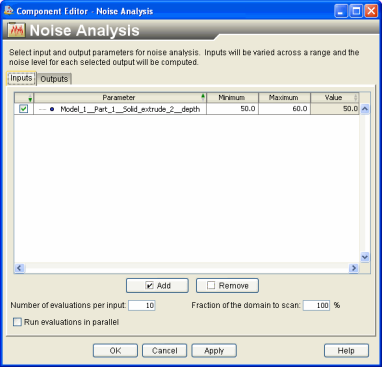About the Noise Analysis Component | ||||
|
| |||
While this component is a general-purpose process component that can operate on any subflow, it is particularly useful for Abaqus or other FEA subflows. The component can help the finite element analyst assess the accuracy and robustness of the model and its suitability for automated design studies in Isight. It is considered a best practice to execute a noise analysis of an Abaqus component prior to running optimization studies, using Monte Carlo simulation, executing Design of Experiments, or creating approximations.
For each input variation, selected output parameters are monitored and their noise level is computed. When using this component, noise is defined as the fraction of the time that the slope of the output versus input curve changes sign. A noise level of zero indicates a monotonically increasing or decreasing function. Noise levels approaching one indicate that multiple local minima and maxima are present. The extrema could be an accurate output of the subflow or could indicate some modeling inaccuracy. For an example of how the component can be used to reduce model noise, see A Simple Noise Analysis Example.
To use the Noise Analysis component, you:
-
Specify the input parameters for the noise scan, as well as the number of subflow evaluations and fraction options.
-
Specify the output parameters for the noise scan.
The following figure shows an example of the Noise Analysis Component Editor:

When the component is executed, noise levels and warnings are displayed on the Isight Runtime Gateway. For more information about the displayed information, see About FEA Noise Check Execution Results.
To start the Noise Analysis Component Editor,
double-click the Noise Analysis component icon ![]() . When you have finished configuring the
Noise Analysis Component Editor, click OK
to close the editor. For more information about inserting components
and accessing component editors, see Working with Components in the Isight User’s Guide.
. When you have finished configuring the
Noise Analysis Component Editor, click OK
to close the editor. For more information about inserting components
and accessing component editors, see Working with Components in the Isight User’s Guide.